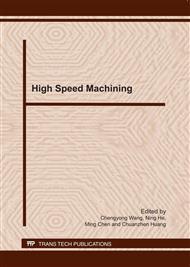[1]
R. Komanduri, Z. -B. Hou, On the thermoplastic shear instability in the machining of a titanium alloy (Ti–6Al–4V), Metall. Mater. Tran. 33A (2002) 2995-3010.
DOI: 10.1007/s11661-002-0284-1
Google Scholar
[2]
R. Komanduri, T.A. Schroeder, On shear instability in machining nickel-iron base superalloy, ASME J. Eng. Ind. 108 (1986) 93-100.
DOI: 10.1115/1.3187056
Google Scholar
[3]
R. Komanduri, T.A. Schroeder, J. Hazra, B.F. von Turkovich, D.G. Flom, On the catastrophic shear instability in high-speed machining of an AISI 4340 steel, ASME J. Eng. Ind. 104 (1982) 121-131.
DOI: 10.1115/1.3185807
Google Scholar
[4]
B. Denkena, R. Ben Amor, L. de León-García and J. Dege, Material specific definition of the high speed cutting range, Int. J. Machining and Machinability of Materials, 2 (2) (2007) 176-185.
DOI: 10.1504/ijmmm.2007.013781
Google Scholar
[5]
K. Nakayama, M. Arai, T. Kanda, Machining characteristics of hard materials, CIRP Annals 37 (1) (1988) 89-92.
DOI: 10.1016/s0007-8506(07)61592-3
Google Scholar
[6]
M.C. Shaw, A. Vyas, Chip formation in the machining of hardened steel, CIRP Annals 42 (1) (1993) 29-33.
DOI: 10.1016/s0007-8506(07)62385-3
Google Scholar
[7]
R. Recht, A dynamic analysis of high speed machining, ASME J. Eng. Ind. 107(1) (1985) 309-315.
Google Scholar
[8]
R. Komanduri, B.F.V. Turkovich, New observations on the mechanism of chip formation when machining titanium alloys, Wear 69 (1981) 179-188.
DOI: 10.1016/0043-1648(81)90242-8
Google Scholar
[9]
J. Barry, G. Byrne, D. Lennon, Observations on chip formation and acoustic emission in machining Ti–6Al–4V alloy, Int. J. Mach. Tool. Manu. 41 (2001) 1055-1070.
DOI: 10.1016/s0890-6955(00)00096-1
Google Scholar
[10]
K. Nakayama, The formation of saw tooth chips, Internat. Conf. on Prod. Eng., Tokyo, (1974) 572-577.
Google Scholar
[11]
M. C. Shaw, and A. Vyas, The Mechanisms of Chip Formation With Hard Turning Steel, CIRP Annals 47(1) (1998) 77–82.
DOI: 10.1016/s0007-8506(07)62789-9
Google Scholar
[12]
R. F. Recht, A dynamic analysis of high speed machining, ASME J. Eng. Ind. 107(1985) 309-315.
Google Scholar
[13]
Y. B. Guo, David W. Yen, A FEM study on mechanisms of discontinuous chip formation in hard machining, J. Mater. Process. Technol. 155–156 (2004) 1350–1356.
DOI: 10.1016/j.jmatprotec.2004.04.210
Google Scholar
[14]
J. Lorentzon, N. Järvsträt, B.L. Josefson, Modeling chip formation of alloy 718, J. Mater. Process. Technol. 209 (2009) 4645-4653.
DOI: 10.1016/j.jmatprotec.2008.11.029
Google Scholar
[15]
J. Buda. New methods in the study of plastic deformation in the cutting zone. CIRP Annals, 21(1972) 17-18.
Google Scholar
[16]
Gente A, Hoffmeister HW, Chip formation in machining Ti–6Al–4V at extremely high cutting speeds. CIRP Annals 50/1 (2001) 49–52.
DOI: 10.1016/s0007-8506(07)62068-x
Google Scholar


